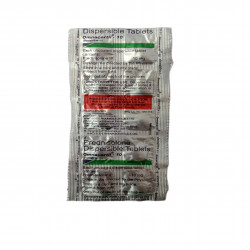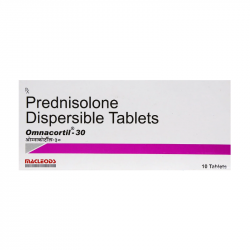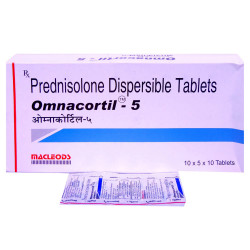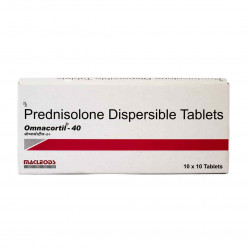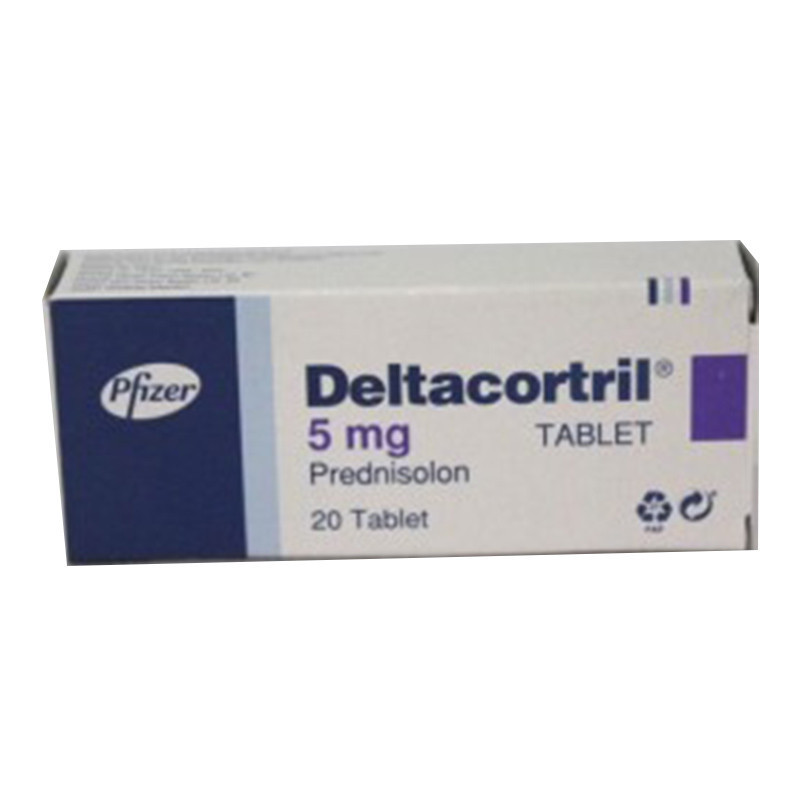

Deltacortril is a glucocorticosteroid. This medication inhibits the function of leukocytes and tissue macrophages. Deltacortril restricts the migration of leukocytes in the area of inflammation. This drug violates the ability of macrophages to phagocytosis and the formation of interleukin-1. Deltacortril contributes to the stabilization of lysosomal membranes, thereby reducing the concentration of proteolytic enzymes in inflammation. This medicine decreases capillary permeability caused by histamine release. Deltacortril inhibits the activity of fibroblasts and collagen formation.
Deltacortril inhibits the activity of phospholipase A2 which leads to suppression of the synthesis of prostaglandins and leukotrienes. This medication inhibits the release of COX (especially COX-2), which also helps reduce the production of prostaglandins.
Deltacortril reduces the number of circulating lymphocytes (T-and B-cells), monocytes, eosinophils and basophils as a result of their displacement from the bloodstream into lymphoid tissue; suppresses the formation of antibodies.
Deltacortril inhibits the release of pituitary ACTH and beta-lipotropina but it does not reduces the level of circulating beta-endorphin. This drug also inhibits the secretion of TSH and FSH.
Deltacortril has a vasoconstrictor effect with direct application to the vessels.
Deltacortril has a pronounced dose-dependent effect on the metabolism of carbohydrates, proteins and fats. It stimulates gluconeogenesis, amino acid contributes to the capture of the liver and kidneys and increases the activity of enzymes of gluconeogenesis. In the liver, Deltacortril enhances the deposition of glycogen by stimulating the activity of glikogensintetazy and synthesis of glucose from the products of protein metabolism. This medicine increases blood glucose activates the secretion of insulin.
Deltacortril inhibits glucose uptake by fat cells that leads to the activation of lipolysis. However, due to an increase in insulin secretion is stimulated lipogenesis which contributes to the accumulation of fat.
Deltacortril also has catabolic effects in lymphoid and connective tissue, muscle, adipose tissue, skin, bone tissue. To a lesser extent than hydrocortisone Deltacortril affects the processes of water and electrolyte metabolism: promotes the excretion of potassium and calcium, delay in the body of sodium and water. Osteoporosis and Itsenko-Cushings syndrome are the main factors limiting the long-term therapy with corticosteroids. As a result of the catabolic actions it may suppress growth in children.
In high doses prednisone can increase the excitability of brain tissue and contributes to lowering the threshold of convulsive readiness. This medication stimulates the excessive production of hydrochloric acid and pepsin in the stomach which leads to the development of peptic ulcers.
When systemic use the therapeutic activity of Deltacortril is due to anti-inflammatory, antiallergic, immunosuppressive and antiproliferative action.
For external and local application the therapeutic activity of Deltacortril is due to anti-inflammatory, antiallergic and antiexudative (due to vasoconstrictor effect) effect.
As compared with hydrocortisone the anti-inflammatory activity of Deltacortril is 4 times greater, the mineralocorticoid activity is 0.6 times smaller.
Why is Deltacortril prescribed?
For oral and parenteral use: rheumatism; rheumatoid arthritis, dermatomyositis, periarteritis nodosa, scleroderma, ankylosing spondylitis, asthma, asthmatic status, acute and chronic allergic diseases, anaphylaxis, Addisons disease, acute adrenal insufficiency, adrenogenital syndrome; hepatitis, hepatic coma, hypoglycemic states, lipid nephrosis; agranulocytosis, various forms of leukemia, lymphoma, thrombocytopenic purpura, hemolytic anemia; chorea; pemphigus, eczema, pruritus, exfoliative dermatitis, psoriasis, pruritus, seborrheic dermatitis, SLE, erythroderma, alopecia.
For intra-articular administration: chronic arthritis, post-traumatic arthritis, osteoarthritis of large joints, rheumatic destruction of individual joints, arthritis.
For the introduction of infiltration in the tissue: epicondylitis, tenosynovitis, bursitis, frozen shoulder, keloids, sciatica, Dupuytrens contracture, rheumatism and similar lesions of joints and various tissues.
For use in ophthalmology: allergies, chronic and atypical conjunctivitis and blepharitis; inflammation of the cornea with intact mucosa; acute and chronic inflammation of the anterior segment of the choroid, sclera and episcleritis; sympathetic inflammation of the eyeball; after injuries and operations during prolonged stimulation of eyeballs.
Dosage and administration
When Deltacortril administered orally for replacement therapy in adults the initial dose is 20-30 mg, maintenance dose is 10.5 mg day. If necessary, the initial dose is may be 15-100 mg day, the maintenance one is 5-15 mg day. The daily dose should be reduced gradually. For children the starting dose is 1-2 mg kg in 4-6 receptions, the maintenance one is 3-6 mg kg day.
For IM or IV dose administration the multiplicity and duration of application are determined individually.
When intra-articular administration in large joints it used a dose of 25-50 mg, for medium-sized joints - 10-25 mg for small joints - 5-10 mg. For the introduction of infiltration into the tissues depending on disease severity and magnitude of the defeat use doses from 5 mg to 50 mg.
Deltacortril used topically in ophthalmology 3 times day, course of treatment is no more than 14 days; in dermatology - 1-3 times day.
Deltacortril side effects, adverse reactions
Endocrine system: menstrual irregularities, suppression of adrenal function, Itsenko-Cushings syndrome, suppression of pituitary-adrenal system, reduced tolerance to carbohydrates, steroid diabetes, or a manifestation of latent diabetes, growth retardation in children, delayed sexual development in children.
Digestive system: nausea, vomiting, steroid ulcer and duodenal ulcer, pancreatitis, esophagitis, bleeding and perforation of the gastrointestinal tract, increased or decreased appetite, flatulence, hiccups. In rare cases - elevated liver transaminases and alkaline phosphatase.
Metabolism: the negative nitrogen balance due to protein catabolism, increased excretion of calcium from the body, hypocalcemia, weight gain, increased sweating.
Cardiovascular system: the loss of potassium, hypokalemic alkalosis, arrhythmia, bradycardia ; steroid myopathy, heart failure (the development or worsening of symptoms), ECG changes typical of hypokalemia, increased blood pressure, hypercoagulability, thrombosis. In patients with acute myocardial infarction - the spread of necrosis, slowing the formation of scar tissue that can lead to rupture of the heart muscle.
Musculoskeletal system: slowing growth and ossification processes in children (premature closure of epiphyseal growth zones) and osteoporosis (very rarely - pathological fractures, aseptic necrosis of the humeral head and femoral), rupture of tendons of muscles, muscle weakness, steroid myopathy, loss of muscle mass (atrophy).
CNS: headache, increased intracranial pressure, delirium, disorientation, euphoria, hallucinations, manic-depressive psychosis, depression, nervousness or anxiety, insomnia, dizziness, vertigo, pseudotumor cerebellum, and seizures.
Vision: the rear subcapsular cataracts, increased intraocular pressure (with the possible damage to the optic nerve), trophic changes of the cornea, exophthalmos, the propensity to develop secondary infections (bacterial, fungal, viral).
Dermatological reactions: petechiae, ecchymosis, thinning and fragility of the skin, hyper- or hypopigmentation, acne, stretch marks, susceptibility to the development of pyoderma and candidiasis.
Reactions due to immunosuppressive effect: slow process of regeneration, reduced resistance to infections.
For parenteral administration: in rare cases of anaphylactic and allergic reactions, hyper- or hypopigmentation, atrophy of skin and subcutaneous tissue, exacerbation after intrasinovialnogo applications such as Charcot arthropathy, sterile abscesses, when injected into pockets on the head - blindness.
-
Glucocorticosteroid
-
20-30 mg/day
-
No
-
No
-
Possible
-
No
-
No
Add a Review
Your email address will not be published. Required fields are marked *
Submit a Photo
Your email address will not be published. Required fields are marked *

